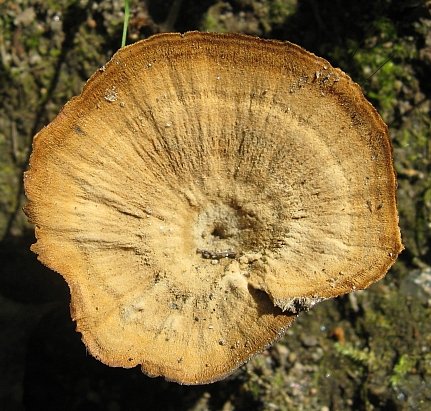Overhead view of Coltricia cinnamomea, taken in woods near La Ronge, Saskatchewan.
Classification
Kingdom Fungi
Phylum Basidiomycota
Class Basidiomycetes
Order Hymenochaetales
Family Hymenochaetaceae
Genus Coltricia
Synonyms
Boletus cinnamomeus Jacq.
Coltricia oblectans (Berk.) G. Cunn.
Coltricia parvula (Klotzsch) Murrill
Coltricia perennis f. casimiri (Velen.) Bondartsev
Microporus bulbipes (Fr.) Kuntze
Microporus cinnamomeus (Jacq.) Kuntze
Microporus oblectans (Berk.) Kuntze
Microporus parvulus (Klotzsch) Kuntze
Pelloporus cinnamomeus (Jacq.) Quél.
Pelloporus fimbriatus var. cinnamomeus (Jacq.) Quél.,
Polyporus baudysii Kavina
Polyporus bulbipes Fr.
Polyporus bulbipes var. cladonia (Berk.) Sacc.
Polyporus casimirii Velen. [as ‘casimiri’]
Polyporus cinnamomeus (Jacq.) Pers.
Polyporus cladonia Berk.
Polyporus oblectans Berk.
Polyporus parvulus Klotzsch
Polyporus splendens Peck
Polyporus subsericeus Peck
Polystictus bulbipes (Fr.) Fr.
Polystictus cinnamomeus (Jacq.) Sacc.
Polystictus cladonia (Berk.) Sacc.
Polystictus oblectans (Berk.) Cooke
Polystictus parvulus (Klotzsch) Fr.
Polystictus perennis f. casimiri (Velen.) Pilát
Polystictus perennis f. cinnamomeus (Jacq.) Pilát
Strilia cinnamomea (Jacq.) Gray
Strilia cinnamomeus (Jacq.) Gray
Xanthochrous bulbipes (Fr.) Pat.
Xanthochrous cinnamomeus (Jacq.) Pat.
Xanthochrous oblectans (Berk.) Pat.
Xanthochrous parvulus (Klotzsch) Pat.
Xanthochrous splendens (Peck) Pat.
Common names
Shiny cinnamon polypore
Description
Cap: circular, 1.0-5.0 cm across, shallowly to strongly infundibuliform, sometimes merely plano-depressed or umbilicate; margin at maturity deflexed, wavy, thin, entire to eroded; when young, growing around and incorporating twigs and debris; surface reddish-brown, rust-brown, to chestnut-brown, usually faintly-zonate, velutinate at the disc, elsewhere silky to coarsely, appressed fibrils, if the former, then somewhat shiny in appearance; context thin, 0.5-2.0 mm thick, colored like the cap surface, blackish with 3% KOH.
Hymenophore: Pore layer adnate to subdecurrent, cinnamon-brown to tan; pores 2-3 per mm, elongate at first, angular and thin-walled in age; tubes 1-2 mm deep, concolorous with the pore surface.
Stem: 1-4 cm long, 1-3 mm thick, central, round to compressed, solid, equal except enlarged at the base, the latter often fused with adjacent fruiting bodies; surface finely velutinous, rust-brown to dull orange-brown; context leathery when fresh, rigid at maturity, colored like the stem surface.
Spores: 6.5-8.5 x 4.5-5.0 µm, oblong to ellipsoid, smooth, thin-walled, inequilateral, slightly bean-shaped in profile.
Habitat: scattered, gregarious, to caespitose, in soil and humus in mixed or coniferous woods; fruiting winter and spring along the coast.
Edibility: inedible, leathery.
Medicinal properties
Antitumor effects
Polysaccharides extracted from the mycelial culture of C. cinnamomea and administered intraperitoneally into white mice at a dosage of 300 mg/kg inhibited the growth of Sarcoma 180 and Ehrlich solid cancers by 90% and 100%, respectively (Ohtsuka et al., 1973).

My name is Austin Collins.
I've dedicated my life to Mushrooms.
I believe Mushrooms are the best kept secret when it comes to health and well being.
For that reason, I would like to share a company with you that in my opinion makes the best mushroom products on the market.
The company is called Noomadic Herbals, my favorite supplement they make is called "Mushroom Total".
I take their products every day and they have helped me think better and have more energy. Give them a try.
-Austin
Ohtsuka S, Ueno S, Yoshikumi C, Hirose F, Ohmura Y, Wada T, Fujii T, Takahashi E.
Polysaccharides having an anticarcinogenic effect and a method of producing them from species of Basidiomycetes.
UK Patent 1331513, 26 September 1973.



